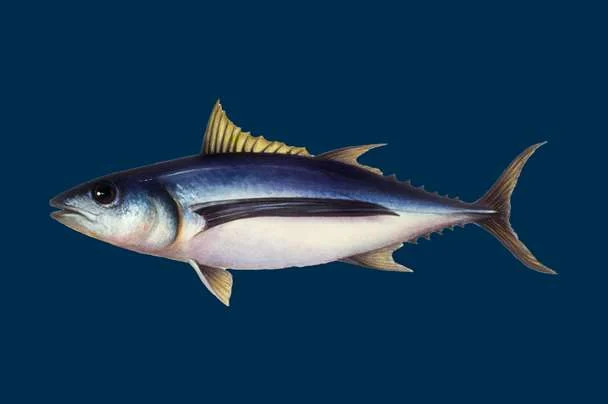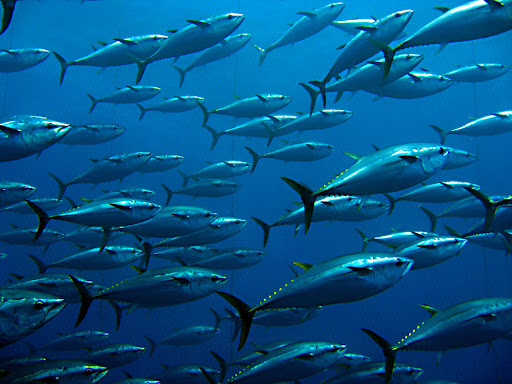Albacore tuna (Thunnus alalunga), known also as the longfin tuna、albacore 。 a species of the Thunnidae family, has long been recognized as one of the most commercially valuable tuna species. It is distinctively known for its elongated pectoral fins and is often referred to as "longfin tuna." The name alalunga, meaning "longfin" in Latin, refers to the prominent pectoral fins that extend far beyond the body of the fish.
Historically, albacore tuna has been an important species for both industrial and artisanal fishing, especially in countries like Japan, the United States, and throughout the Mediterranean. Their meat, particularly in sushi or canned forms, is highly prized, making them a cornerstone of the global seafood market.
Albacore tuna's scientific classification is as follows:
Kingdom: Animalia
Phylum: Chordata
Class: Actinopterygii
Order: Perciformes
Family: Thunnidae
Genus: Thunnus
Species: T. alalunga
Albacore tuna exhibit distinct physical features that set them apart from other tuna species, like bluefin and yellowfin. These characteristics include:
Size and Body Length: Adult albacore tuna can grow up to 1.4 meters (4.5 feet) long and typically weigh between 20 to 45 kilograms (44 to 99 pounds), although individuals can exceed these measurements in exceptional cases.
Distinctive Pectoral Fins: The most noticeable feature of albacore tuna is its long pectoral fins, which can be nearly a quarter of the body length. This adaptation allows the species to maneuver efficiently in the ocean.
Coloration: Albacore tuna have a dark blue dorsal side with a silvery belly, which helps camouflage them from predators and prey.
Lifespan: Albacore tuna can live up to 10-15 years, with some individuals reaching up to 20 years in optimal conditions.
Their streamlined body and fast swimming capabilities make them excellent predators of smaller fish and squid.
Albacore tuna are widely distributed across the world’s oceans. They are found in temperate and subtropical waters, primarily in the Atlantic, Pacific, and Indian Oceans.
Habitat: Albacore are pelagic, meaning they inhabit the open ocean and are often found in deep waters, ranging from 200 to 500 meters (656 to 1,640 feet) deep. They avoid coastal waters and prefer cooler, offshore regions.
Temperature Preferences: They thrive in waters between 15°C to 22°C (59°F to 72°F), where they can find abundant prey such as small fish and squid.
Global Distribution:
Atlantic Ocean: From the Mediterranean Sea to the eastern coast of North America.
Pacific Ocean: From Japan to the west coast of the Americas.
Indian Ocean: Found in offshore waters around Southeast Asia and Australia.
Their migratory nature means that they travel long distances between feeding and breeding grounds, often crossing entire ocean basins.

Albacore tuna play a crucial role in the marine food web as apex predators. Their behavior is shaped by the need to hunt efficiently and navigate vast oceanic territories.
Predatory Behavior: As carnivorous fish, albacore tuna primarily feed on small pelagic fish like sardines, anchovies, and mackerel, as well as squid. Their hunting strategy involves high-speed chases, where they utilize bursts of speed to catch fast-moving prey.
Solitary Nature: Unlike other tuna species that may form schools, albacore tuna are generally solitary except during feeding times or migrations.
Sensory Adaptations: They possess specialized sensory systems, such as their highly developed vision, which allows them to track prey at significant depths.
These behaviors make albacore tuna one of the fastest and most efficient predators in the ocean.
Albacore tuna are known for their migratory nature, traveling extensive distances between feeding and spawning grounds.
Migration Routes: Albacore tuna migrate across vast oceanic expanses. For example, those in the Atlantic Ocean travel between the Mediterranean and North American coasts, while Pacific albacore migrate between Japan and the western Americas.
Temperature-Driven Movements: They are sensitive to water temperature and migration is largely driven by the search for optimal feeding conditions and suitable spawning areas.
Spawning Grounds: Albacore tuna spawn in tropical and subtropical waters, typically in areas where oceanographic conditions (such as water temperature and nutrient upwelling) are ideal for larval development.
Their migration patterns are a key factor in their life cycle and are important for fisheries management.
While albacore tuna are not typically social animals, their daily activities revolve around feeding and migration:
Feeding: They are active predators and spend a significant portion of their time hunting for food, either during the day or night, depending on prey availability.
Swimming Patterns: Their swimming behavior is highly adapted to chasing prey, with strong, fast bursts of speed that can reach up to 75 kilometers per hour (47 miles per hour).
Resting: While not much is known about their resting patterns, tuna generally do not sleep in the conventional sense, but engage in periods of reduced activity.
Albacore tuna’s behavior is mainly driven by the need to consume sufficient food to fuel their high metabolic rate and long migrations.
Albacore tuna have a carnivorous diet, and their feeding strategies are built around their speed and agility. They primarily feed on:
Small Pelagic Fish: Albacore tuna’s diet mainly consists of small fish species, including anchovies, mackerel, and sardines.
Squid: Albacore tuna also consume squid, particularly during seasonal migrations when squid are abundant.
Feeding Strategy: Albacore utilize their sharp vision and high swimming speeds to chase and capture prey in deep waters. They are known to ambush schools of fish and catch them by surprise.
Their efficient feeding strategy is essential for sustaining their migratory behavior and fast lifestyle.
Reproduction in albacore tuna is highly adaptive, with the species exhibiting characteristics typical of tunas:
Spawning: Albacore tuna spawn in tropical and subtropical regions, typically in waters around 22°C (72°F). They engage in external fertilization, where eggs are released by females and fertilized by males.
Eggs and Larvae: Albacore tuna eggs are pelagic and float on the ocean’s surface. Larvae hatch within a few days, and their development is rapid.
Sexual Maturity: Albacore tuna reach sexual maturity at around 5-6 years of age, at which point they begin spawning annually.
Their high reproductive rate is essential for sustaining the population despite the pressures of commercial fishing.
Albacore tuna are currently classified as "Least Concern" by the International Union for Conservation of Nature (IUCN), indicating that the species is not currently at significant risk of extinction globally. However, regional populations face varying levels of threat due to overfishing and environmental changes.
Albacore tuna populations are managed through various international fisheries agreements and conservation measures to prevent overexploitation:
Fishing Quotas: Many nations that harvest albacore tuna adhere to annual catch limits established by organizations like the International Commission for the Conservation of Atlantic Tunas (ICCAT) and the Western and Central Pacific Fisheries Commission (WCPFC).
Sustainable Fisheries: There has been a significant push toward sustainable fishing practices, including improved catch reporting, monitoring, and bycatch reduction techniques.
Marine Protected Areas: Certain regions, such as key spawning areas, have been designated as protected zones to limit fishing activities and allow tuna populations to replenish.
These efforts are critical in maintaining the species' population and ensuring the health of marine ecosystems.
While albacore tuna populations are stable overall, some regional stocks are experiencing declines due to overfishing, illegal fishing activities, and climate change impacts on migration and spawning patterns. The population is regularly assessed to ensure sustainability.

Despite their status as apex predators, albacore tuna face threats from both human activities and natural predators:
Human Threats: Overfishing, illegal fishing, habitat degradation, and the impact of climate change on ocean temperatures and prey availability are significant threats to their populations.
Natural Predators: Larger aquarium/52-marine-animals.html">marine animals such as sharks, orcas, and even larger tunas are known to prey on albacore tuna, especially young individuals.
To preserve albacore tuna populations, international organizations and national governments have implemented various conservation measures:
Fishing Limits: Enforcing sustainable fishing quotas and reducing overfishing to ensure the long-term viability of tuna populations.
Marine Conservation Zones: Establishing protected marine areas where fishing is restricted to allow tuna populations to recover and thrive.
Bycatch Reduction: Introducing technologies to reduce bycatch in tuna fisheries, particularly for vulnerable species.
As apex predators in the ocean, albacore tuna play a crucial role in maintaining the health of marine ecosystems. By controlling the population of smaller fish and squid, they help regulate the food chain and support biodiversity.
Albacore tuna is integral to the cultures of many coastal communities, especially in Japan, where it is a key ingredient in sushi. It is also important in the Mediterranean and the United States, where it is widely consumed both fresh and canned.
The economic value of albacore tuna is significant, with global markets for both canned and fresh tuna generating billions of dollars annually. Albacore is particularly important in the seafood industry, contributing to jobs in fishing, processing, and distribution.
The annual global catch of albacore tuna is estimated at around 300,000 to 400,000 metric tons, with major producers including Japan, the United States, and European nations. Albacore tuna is vital for both commercial fisheries and local artisanal fishing operations.
| Variety | Price per Pound (USD) |
|---|---|
| Premium Sushi Grade | $20 - $30 |
| Fresh Albacore | $10 - $20 |
| Frozen Albacore | $8 - $15 |
| Canned Albacore | $2 - $5 |
This comprehensive guide provides a detailed overview of albacore tuna, from its biology and global distribution to its role in marine ecosystems and the economy. By understanding its complexities, we can better appreciate the importance of conservation and sustainable management of this valuable species.
animal tags: albacore-tuna
We created this article in conjunction with AI technology, then made sure it was fact-checked and edited by a Animals Top editor.